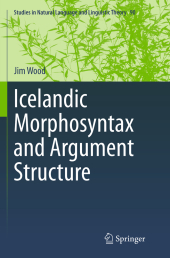 Neuerscheinungen 2016Stand: 2020-02-01 |
Schnellsuche
ISBN/Stichwort/Autor
|
Herderstraße 10
10625 Berlin
Tel.: 030 315 714 16
Fax 030 315 714 14
info@buchspektrum.de |

Jim Wood
Icelandic Morphosyntax and Argument Structure
Softcover reprint of the original 1st ed. 2015. 2016. xxi, 316 S. 76 SW-Abb., 11 Tabellen. 235 mm
Verlag/Jahr: SPRINGER, BERLIN; SPRINGER INTERNATIONAL PUBLISHING 2016
ISBN: 3-319-34811-6 (3319348116)
Neue ISBN: 978-3-319-34811-7 (9783319348117)
Preis und Lieferzeit: Bitte klicken
This book provides a detailed study of Icelandic argument structure alternations within a syntactic theory of argument structure. Building on recent theorizing within the Minimalist Program and Distributed Morphology, the author proposes that much of what is traditionally attributed to syntax should be relegated to the interfaces, and adapts the late insertion theory of morphology to semantics. The resulting system forms sound-meaning pairs by generating hierarchical structures that can be translated into morphological representations, on the one hand, and semantic representations, on the other. The syntactic primitives, however, underdetermine both morphophonology and semantics. Without appealing to special stipulations, the theory derives constraints on the external argument of causative-alternation verbs, interpretive restrictions on nominative objects, and the optionally agentive interpretation of verbs denoting self-directed motion.
Introduction.- 1.1 Aim and Scope.- 1.2 The Present System.- 1.2.1 Syntax.- 1.2.2 The Syntactic Pieces.- 1.2.3 Morphology.- 1.2.4 Semantics.- 1.2.5 Interpretation and Allosemy.- 1.2.6 What Are ´Argument Structure Alternations´?.- 1.3 On the Data.- 1.4 A Brief Overview of Icelandic Morphosyntax.- 1.4.1 Oblique Subjects and Case Morphology.- 1.4.2 Expletive Constructions.- 1.4.3 Verb Movement and Word Order.- 1.4.4 Simplex, Complex, and Long- Distance Reflexives.- 1.4.5 Progressive Aspect.- 1.4.6 The New Impersonal Passive and Dative-Accusative Constructions.- 1.5 Outline of the Remainder of the Book.- 2. The Morphosyntax of -st .- 2.1 Introduction.- 2.2 On -st Morphology: What -st is and isn´t.- 2.2.1 Reflexive -st Verbs.- 2.2.2 -st is Not (Usually) Passive.- 2.2.3 -st Appears to be Caseless.- 2.2.4 -st Has One or More -Features.- 2.3 Clitic properties of -st .- 2.3.1 Positioning and distributional properties.- 2.3.2 Paradigmatic properties- the ´form´ of -st .- 2.3.3 Morphophonological properties.- 2.3.4 Inherent -st Verbs.- 2.3.5 The Idiosyncrasy of -st : Special Meaning is No Special Problem.- 2.3.6 Alternating with a ´word´.- 2.3.7 Summary.- 2.4 Possible Clitic Analysis of -st .- 2.4.1 Right Adjunction.- 2.4.2 Defective Goal.- 2.4.3 Adjunction to X´ or Movement to Dedicated Specifier Position.- 2.5 Does it matter if -st is a clitic?.- 2.6 Summary.- 3. DP Internal Argument - The Causative Alternation.- 3.1 An Overview of the Causative Alternation.- 3.2 Morphology of Specifierless Voice.- 3.2.1 Unmarked Alternations and -ka Suffixation.- 3.2.2 -na- Marked Alternations.- 3.2.3 Allomorphy-Marked Alternations.- 3.2.4 Summary.- 3.3 Direct Object Datives and Anticausatives.- 3.4 Thematic Interpretation of Causatives/Anticausatives.- 3.4.1 -st Marked Anticausatives.- 3.4.2 -nal -Marked Anticausatives.- 3.4.3 Specifierless Voice Versus no Voice at all.- 3.4.4 Summary.- 3.4.5 Root Distribution in Anticlausatives.- 3.4.6 Anticausative -st vis-à- vis a DP in SpecVoiceP.- 3.5 Summary.- 4. pP Internal Argument - Figure Reflexives and Object ´Demotion´.- 4.1 An Overview of the Syntax of Figure and Ground.- 4.2 Thematic Interpretation of Figure Reflexives.- 4.2.1 -st-Marked Figure Reflexives.- 4.2.2 Unmarked Figure Reflexives.- 4.2.3 Figure Reflexives vis-à- vis Reflexive Pronouns.- 4.2.4 Root Distribution in Figure Reflexives.- 4.3 Expletive p.- 4.3.1 Internal Argument ´Demotion´.- 4.3.2 Expletive Voice and Expletive p Together.- 4.4 Summary.- 5. Applicatives and Applied Datives.- 5.1 A Typology of Icelandic Applicatives.- 5.1.1 High Applicatives.- 5.1.2 Low Applicatives.- 5.1.3 High-Low Applicatives.- 5.2 "Valency Reduction" of ApplP.- 5.2.1 Anticausatives of Ditransitives.- 5.2.2 -st in SpecApplP.- 5.2.3 Ingestives and Specerfierless Appl.- 5.2.4 Root Distribution in Ingestives.- 5.3 Psych-Verbs with Dative Subjects.- 5.4 Summary.- 6. More on the Syntax of -st Verbs.- 6.1 Denominal -st Verbs.- 6.2 Modal Passive -st Verbs and Generic Middles.- 6.3 Causative Láta ´Let´and -st Verbs.- 6.4 Reciprocal -st Verbs.- 6.5 Other Reflexive -st Verbs.- Conclusion.- References.- Index


